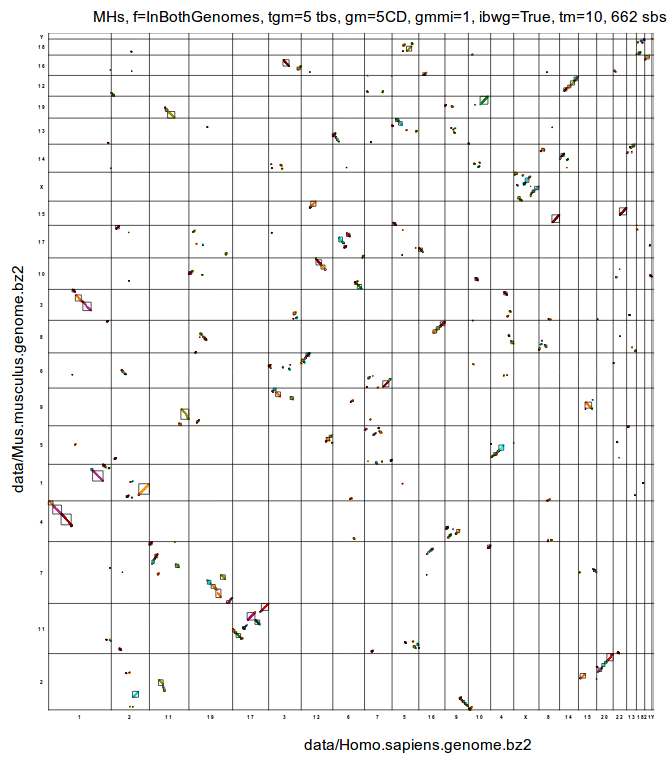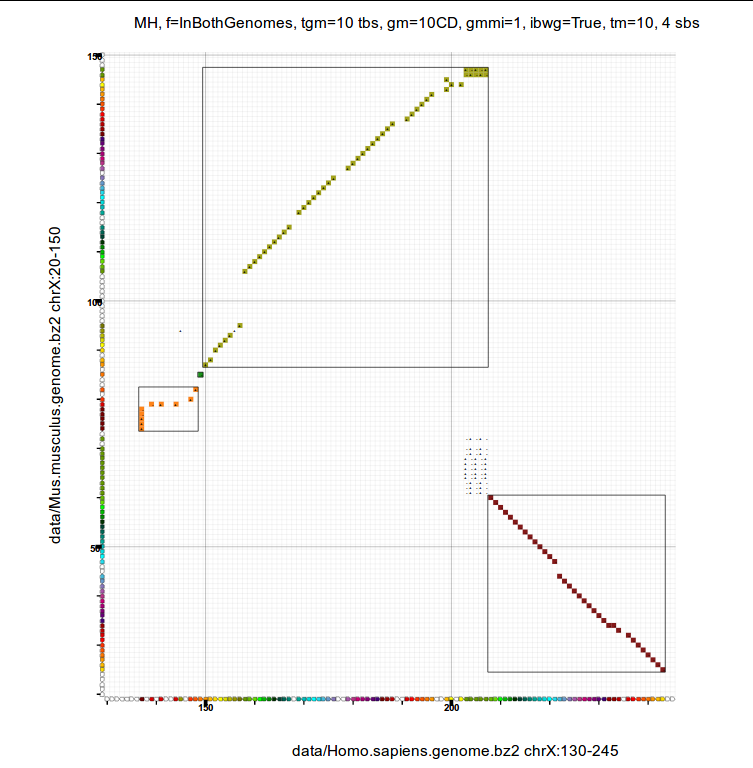From the comparison of two extant genomes and corresponding gene families, PhylDiag detects conserved segments, i.e. segments of chromosomes unbroken during evolution.
Inputs
- two extant genomes, G1 and G2
- a set of gene families, F
Outputs
- conserved segments
Example of
- genome: data/Homo.sapiens.genome
- set of families: data/Euarchontoglires.families
- conserved segments: res/Homo.sapiens_Mus.musculus_fEuarchontoglires.sbs
(phylDiag automatically uncompresses files with extensions *.bz2)
Gene families can be computed from a forest of phylogenetic gene trees, see https://github.com/DyogenIBENS/LibsDyogen.
A genome is a set of chromosomes. A chromosome is a list of genes. A gene is a pair (gene name, transcription orientation).
F, the set of gene families, is an associative array that links, for each family,
- the family name (key)
- to the set of names of the descendant genes (values)
The name of a gene family is often the name of the ancestral gene, at the root of the gene family.
PhylDiag can also return synteny blocks, if
- identification of micro-rearrangements,
- identification of mono-genic conserved segments
are disabled (--no-imr and --no-imcs).
PhylDiag is explained in more details in two publications
- PhylDiag : identifying complex synteny blocks that include tandem duplications using phylogenetic gene trees
- High precision detection of conserved segments from synteny blocks"
and in a thesis manuscript in french
Conserved segments can be considered as a specific type of synteny blocks, with a threshold between micro and macro-rearrangements equal to 0 ancestral genes. For this reason you may see some conserved segments being named more generally synteny blocks in the code, or with the extension *.sbs.
Using Docker, you should be able to install PhylDiag on Linux distributions, MacOS and Windows (7 or later) through docker. (Tested using Windows 10 and Linux) (NB: if you use a Debian distribution, you may prefer to read next section for a more native installation.)
First, install docker.
Then, download the Dockerfile, at the root of the Github deposit of PhylDiag, into ~/Downloads
wget https://raw.githubusercontent.com/DyogenIBENS/PhylDiag/master/Dockerfile -P ~/DownloadsMove into the folder containing the Dockerfile and build the image (let's name it "phyldiagi")
cd ~/Downloads
docker build -t phyldiagi ./(NB: There is no need to install LibsDyogen, Docker will do it after reading the Dockerfile. Building the image may take some time: the output image will contain i-ADHoRe 3.0, Cyntenator and homology teams, in addition to PhylDiag.)
Then:
- Create a container ("phyldiagc") from the image
- Share Input/Output folders between host and container:
- input:
INDIRon the host and/INin container - output:
OUTDIRon the host and/OUTin container
- input:
- Start a bash shell in the container Make these 3 actions with, for instance
INDIR=${PWD} && OUTDIR=${HOME}/phyldiag_results
docker run --name phyldiagc -v ${INDIR}:/IN -v ${OUTDIR}:/OUT -ti phyldiagi bashFrom the new shell, you can use all executables installed in the container to process data from /IN/ to /OUT/, for instance:
PhylDiag/src/phylDiag.py /IN/Homo.sapiens.genome.bz2 /IN/Mus.musculus.genome.bz2 /IN/Euarchontoglires.families.bz2 > /OUT/res.sbsExit the container with exit.
Later you can go back inside the container with:
docker start -i phyldiagcIf you are on Windows:
- Make sure that Docker is activated and that it uses Hyper-V; by default it should be the case
- Start windows Powershell
- Change directories with backslashes instead of slashes (e.g. cd
.\path\folder\containingDockerfile\) - Once you are in the folder of the dockerfile, build the image with
docker build .\ - Run the image with
docker run --name phyldiagc -v /c/Users/<user>/Desktop:/IN -it phyldiagi /bin/bash, with , your user name
Install the LibsDyogen library first. From now on we assume that the path to the folder LibsDyogen is in the PYTHONPATH.
The easiest way to install PhylDiag is to launch the remote script INSTALL.sh hosted on github. This script will clone the github deposit itself. The installation will be set in /home/${USER}/Libs/PhylDiag.
Install curl, if you don't have it
sudo apt-get update
sudo apt-get install curl
Use curl to execute the remote file INSTALL.sh hosted on github
bash <(curl -s https://raw.githubusercontent.com/DyogenIBENS/PhylDiag/master/INSTALL.sh)
If it did not work, follow the next instructions.
Core dependencies
- LibsDyogen
Choose a path for the parent folder of PhylDiag (here it is /home//Libs)
mkdir -p ${PATH_PARENT_PHYLDIAG}
cd ${PATH_PARENT_PHYLDIAG}
PATH_PHYLDIAG=${PATH_PARENT_PHYLDIAG}/PhylDiag
Clone the PhylDiag deposit
git clone https://github.com/DyogenIBENS/PhylDiag ${PATH_PHYLDIAG}
If necessary give execution rights
chmod +x ${PATH_PHYLDIAG}/src/*.py
chmod +x ${PATH_PHYLDIAG}/src/analysis/*.py
chmod +x ${PATH_PHYLDIAG}/src/postprocessing/*.py
It should be installed. You can verify that everything works properly with some tests
cd PhylDiag
bash ./checkPhylDiagIntegrity.sh
We assume that you are in the main folder of PhylDiag.
src/phylDiag.py --help
returns
usage: phylDiag.py [-h] [-m MINCHRLEN] [-f {None,InBothGenomes,InFamilies}]
[-t TANDEMGAPMAX] [-d {MD,ED,DPD,CD}] [-g GAPMAX]
[--imr | --no-imr] [--imcs | --no-imcs] [--mmg MMG]
[--truncation | --no-truncation]
[--truncationMax TRUNCATIONMAX] [-v]
G1 G2 F
positional arguments:
G1 genome1
G2 genome2
F set of gene families
optional arguments:
-h, --help show this help message and exit
-m MINCHRLEN, --minChrLen MINCHRLEN
minimum number of genes in considered chromosomes
(default: 2)
-f {None,InBothGenomes,InFamilies}, --filter {None,InBothGenomes,InFamilies}
filter type (default: InBothGenomes)
-t TANDEMGAPMAX, --tandemGapMax TANDEMGAPMAX
maximum gap between tandem duplicates in the same
cluster (default: 10)
-d {MD,ED,DPD,CD}, --distanceMetric {MD,ED,DPD,CD}
metric used for the calculation of 2D distances. CD:
Chebyshev, MD: Manhattan, DPD: Diagonal Pseudo
Distance, ED: Euclidian (default: CD)
-g GAPMAX, --gapMax GAPMAX
maximum 2D gap between chained homologies (default: 5)
--imr identify micro-rearrangements (default: True)
--no-imr
--imcs identify mono-genic conserved segments (default: True)
--no-imcs
--mmg MMG maximum micro-gap, maximum gap allowed between: the
homology of a detectable micro-segment and the nearest
homology of a diagonal (default: 1)
--truncation truncate overlapping diagonals (default: True)
--no-truncation
--truncationMax TRUNCATIONMAX
maximum truncated length of the smallest overlapping
diagonals, above the diag. is fully removed, without
truncation (default: 10)
-v, --verbose verbosity (default: False)
3 files are required :
- genome1
- genome2
- families in this order
Execute phylDiag with default values of options
src/phylDiag.py data/Homo.sapiens.genome.bz2 data/Mus.musculus.genome.bz2 data/Euarchontoglires.families.bz2 > res/consevedSegments.sbs
Here, each family is defined as a set of genes that derive from one gene in Euarchontoglires. Euarchontoglires is the most recent common ancestor of extant human and mouse.
- The distance metric may be either the 'DPD', 'ED', 'MD' or 'CD' (in brackets). The default distance metric is 'CD' (in parenthesis).
- By default the filtering of extant genomes is 'InBothGenomes', meaning that only homologs present in both genomes are kept.
A standard way to launch PhylDiag is
src/phylDiag.py data/Homo.sapiens.genome.bz2 data/Mus.musculus.genome.bz2 data/Euarchontoglires.families.bz2 --tandemGapMax=5 --gapMax=5 --truncationMax=5 > res/consevedSegments.txt
Adding '--verbose' returns more information in logErr
src/phylDiag.py data/Homo.sapiens.genome.bz2 data/Mus.musculus.genome.bz2 data/Euarchontoglires.families.bz2 --tandemGapMax=5 --gapMax=5 --truncationMax=5 --verbose > res/consevedSegments.txt 2> res/logErr.txt
This viewer draw homology matrices with conserved segments.
src/phylDiagViewer.py --help
returns
usage: phylDiagViewer.py [-h] [-m MINCHRLEN]
[-f {None,InBothGenomes,InFamilies}]
[-t TANDEMGAPMAX] [-d {MD,ED,DPD,CD}] [-g GAPMAX]
[--imr | --no-imr] [--imcs | --no-imcs] [--mmg MMG]
[--truncation | --no-truncation]
[--truncationMax TRUNCATIONMAX] [-v]
[--ROI1 chr1:beg1-end1] [--ROI2 chr2:beg2-end2]
[--withSbs | --withoutSbs] [-s INSBS] [-i] [-b] [-r]
[-a SCALERECTS] [--considerAllComps] [-l] [-o OUTSBS]
G1 G2 F IMAGE
Graphical visualisation of synteny blocks in homology matrices
positional arguments:
G1 genome1
G2 genome2
F set of gene families
IMAGE path to the returned image.svg
optional arguments:
-h, --help show this help message and exit
... (same as with phylDiag)
--ROI1 chr1:beg1-end1
region of interest (ROI) on the first genome (default:
None)
--ROI2 chr2:beg2-end2
region of interest (ROI) on the second genome
(default: None)
--withSbs draw sbs in the homology matrix (default: True)
--withoutSbs
-s INSBS, --inSbs INSBS
synteny blocks to draw (*.sbs) (default: None)
-i, --withSbIds draw ids of synteny blocks (default: False)
-b, --geneIdxsToTbIdxs
convert gene idxs to tandem block idxs (default:
False)
-r, --chrsInTbs draw chromosomes in tandem blocks (after collapsing
clusters of tandem duplicates) (default: False)
-a SCALERECTS, --scaleRects SCALERECTS
scale factor of rectangle widths, if they are too
small increase it (default: 1.0)
--onlyROIcomp consider only comparisons of both ROIs (change the
filtering) (default: False)
-l, --liveView turn on direct view with firefox as soon as the
computation is finished (default: False)
-o OUTSBS, --outSbs OUTSBS
information about drawn sbs (default: res/sbs.txt)
Warning: with --withoutSbs it may not return the desired homology matrix
Draw the homology matrix of the comparison of the human and the mouse genomes
src/phylDiagViewer.py data/Homo.sapiens.genome.bz2 data/Mus.musculus.genome.bz2 data/Euarchontoglires.families.bz2 --tandemGapMax=5 --gapMax=5 res/WMH_Hs_Mm.svg --scaleRects=40
The output image can be seen with firefox.

A region of interest is a segment of one chromosome, for instance the section between the 100th gene and the 200th gene of chromosome X in the first genome (--ROI1=X:100-200). Another example: '4:45-80' means chromosome 4 from the 45th gene to the 80th gene.
a=Euarchontoglires
s1=Homo.sapiens
s2=Mus.musculus
c1=X
r1="130-245"
c2=X
r2="20-150"
dm="CD"
gm=10
suffix=Hs_${c1}.${r1}_Mm_${c2}.${r2}_${dm}${gm}
src/phylDiagViewer.py data/${s1}.genome.bz2 data/${s2}.genome.bz2 data/${a}.families.bz2 --distanceMetric=${dm} --gapMax=${gm} --ROI1=$c1:$r1 --ROI2=$c2:$r2 res/MH_${suffix}.svg --outSbs=res/${suffix}.sbs.txt --onlyROIcomp
A ROI may be a whole chromosome, e.g. 'X:1-~' is the ROI of chromosome X from the first gene to the last gene, ~.
Compute the Matrix of Homologies (MH) of the human X chromosome compared to the mouse X chromosome
src/phylDiagViewer.py data/Homo.sapiens.genome.bz2 data/Mus.musculus.genome.bz2 data/Euarchontoglires.families.bz2 --ROI1=X:1-~ --ROI2=X:1-~ res/MH.svg --outSbs=res/sbs.txt
It is also possible to draw the Matrix of Homology Packs (MHP), with the option --chrsInTbs. The MHP is the MH after filtering genomes and collapsing tandem duplicates.
src/phylDiagHomologyMatrixViewer.py data/Homo.sapiens.genome.bz2 data/Mus.musculus.genome.bz2 data/Euarchontoglires.families.bz2 --ROI1=X:1-~ --ROI2=X:1-~ --chrsInTbs ./res/MHP.svg --outSbs=./res/syntenyBlocksDrawerMHP.txt
If you want to keep PhylDiag up to date, update LibsDyogen first (see the Update section of LibsDyogen).
Then
cd ${PATH_LIBSDYOGEN}
git pull
This will upgrade your local git deposit to the last commit.
If you want a more stable version, after git pull, you can downgrade to the latest tagged version (=stable release)
- Get tags from the github deposit
git fetch --tags - Get the latest tag name
latestTag=$(git describe --tags `git rev-list --tags --max-count=1`) - Checkout the latest tag
git checkout $latestTag
After git fetch --tags, you can also switch to any anterior tagged version
- List all tagged versions:
git tag -l - Checkout to the version you want:
git checkout <tagName>
Please ensure that the versions of PylDiag and LibsDyogen share the same tagged version or correspond to their last commits.
If you want to contribute to this deposit please
- fork it
- create your feature branch:
git checkout -b my-new-feature - commit your changes:
git commit -am 'Add some feature' - push to the branch:
git push origin my-new-feature - submit a pull request
- Optimise the computation of the homology matrix with the "sort-join" algorithm of "step2" (page 3)
Khalid Mahmood, Geoffrey I. Webb, Jiangning Song, James C. Whisstock, Arun S. Konagurthu; Efficient large-scale protein sequence comparison and gene matching to identify orthologs and co-orthologs. Nucleic Acids Res 2012; 40 (6): e44. doi: 10.1093/nar/gkr1261
- Draw matrices of homologies with Cairo
- Joseph Lucas: conceptualisation and implementation of phylDiag
- Hugues Roest Crollius: supervision
- Lucas Tittmann: improved the clustering of tandem duplicates
- Nga thi thuy Nguyen: optimisation of the core algorithm of PhylDiag with cython
- Matthieu Muffato: implementation several python functions in LibsDyogen
This code may be freely distributed and modified under the terms of the GNU General Public License version 3 (GPL v3) and the CeCILL licence version 2 of the CNRS. These licences are contained in the files:
- LICENSE-GPL.txt (http://www.gnu.org/licenses/gpl-3.0-standalone.html)
- LICENCE-CeCILL.txt (http://www.cecill.info/licences/Licence_CeCILL_V2-en.html)
Copyright for this code is held jointly by the Dyogen (DYnamic and Organisation of GENomes) team of the Institut de Biologie de l'Ecole Normale Supérieure (IBENS) 46 rue d'Ulm Paris, and the individual authors.
Lucas JM, Roest Crollius H (2017) High precision detection of conserved segments from synteny blocks. PLoS ONE 12(7): e0180198. https://doi.org/10.1371/journal.pone.0180198
